Analyzing Customer Behavior Influence on Grocery Store Purchases
VerifiedAdded on 2023/02/03
|77
|24562
|34
Dissertation
AI Summary
This dissertation investigates the influence of customer behavior on purchasing decisions within the grocery retail sector, using TESCO as a primary case study. The study aims to identify the factors affecting TESCO's market share and profitability, examining customer loyalty, demographic profiles, and the shift from traditional retail to convenient stores. The research includes a comprehensive literature review, a detailed methodology section outlining the research philosophy, approach, design, data collection methods, and ethical considerations. The results section presents findings from frequency tables, correlations, regressions, t-tests, and independent samples tests, followed by a discussion of these findings. The dissertation concludes with recommendations for TESCO, based on the analysis of customer behavior and its impact on purchasing patterns. The research also highlights the importance of understanding consumer behavior and the implications of technological advancements and competition in the retail industry.
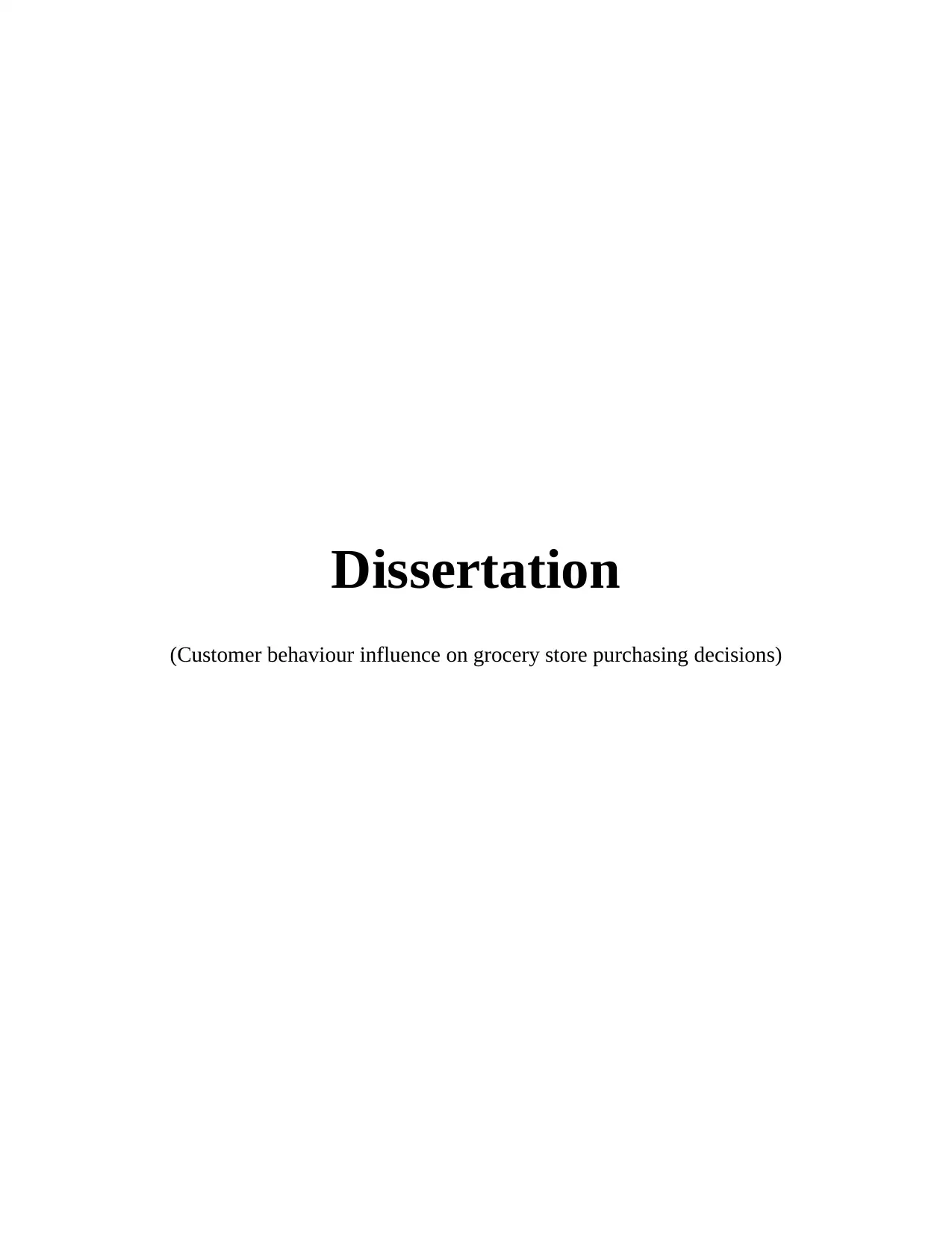
Dissertation
(Customer behaviour influence on grocery store purchasing decisions)
(Customer behaviour influence on grocery store purchasing decisions)
Paraphrase This Document
Need a fresh take? Get an instant paraphrase of this document with our AI Paraphraser
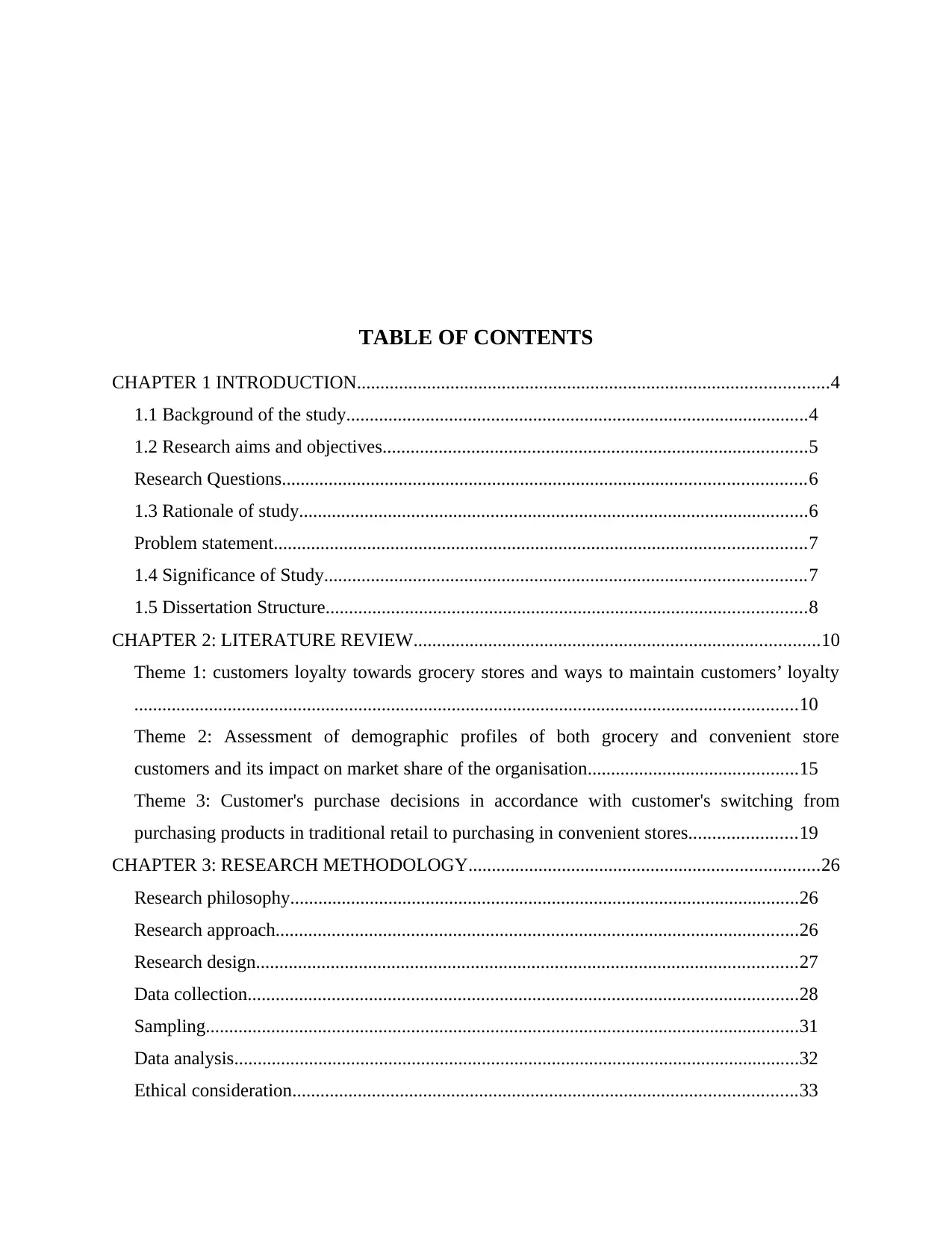
TABLE OF CONTENTS
CHAPTER 1 INTRODUCTION.....................................................................................................4
1.1 Background of the study...................................................................................................4
1.2 Research aims and objectives...........................................................................................5
Research Questions................................................................................................................6
1.3 Rationale of study.............................................................................................................6
Problem statement..................................................................................................................7
1.4 Significance of Study.......................................................................................................7
1.5 Dissertation Structure.......................................................................................................8
CHAPTER 2: LITERATURE REVIEW.......................................................................................10
Theme 1: customers loyalty towards grocery stores and ways to maintain customers’ loyalty
..............................................................................................................................................10
Theme 2: Assessment of demographic profiles of both grocery and convenient store
customers and its impact on market share of the organisation.............................................15
Theme 3: Customer's purchase decisions in accordance with customer's switching from
purchasing products in traditional retail to purchasing in convenient stores.......................19
CHAPTER 3: RESEARCH METHODOLOGY...........................................................................26
Research philosophy.............................................................................................................26
Research approach................................................................................................................26
Research design....................................................................................................................27
Data collection......................................................................................................................28
Sampling...............................................................................................................................31
Data analysis.........................................................................................................................32
Ethical consideration............................................................................................................33
CHAPTER 1 INTRODUCTION.....................................................................................................4
1.1 Background of the study...................................................................................................4
1.2 Research aims and objectives...........................................................................................5
Research Questions................................................................................................................6
1.3 Rationale of study.............................................................................................................6
Problem statement..................................................................................................................7
1.4 Significance of Study.......................................................................................................7
1.5 Dissertation Structure.......................................................................................................8
CHAPTER 2: LITERATURE REVIEW.......................................................................................10
Theme 1: customers loyalty towards grocery stores and ways to maintain customers’ loyalty
..............................................................................................................................................10
Theme 2: Assessment of demographic profiles of both grocery and convenient store
customers and its impact on market share of the organisation.............................................15
Theme 3: Customer's purchase decisions in accordance with customer's switching from
purchasing products in traditional retail to purchasing in convenient stores.......................19
CHAPTER 3: RESEARCH METHODOLOGY...........................................................................26
Research philosophy.............................................................................................................26
Research approach................................................................................................................26
Research design....................................................................................................................27
Data collection......................................................................................................................28
Sampling...............................................................................................................................31
Data analysis.........................................................................................................................32
Ethical consideration............................................................................................................33
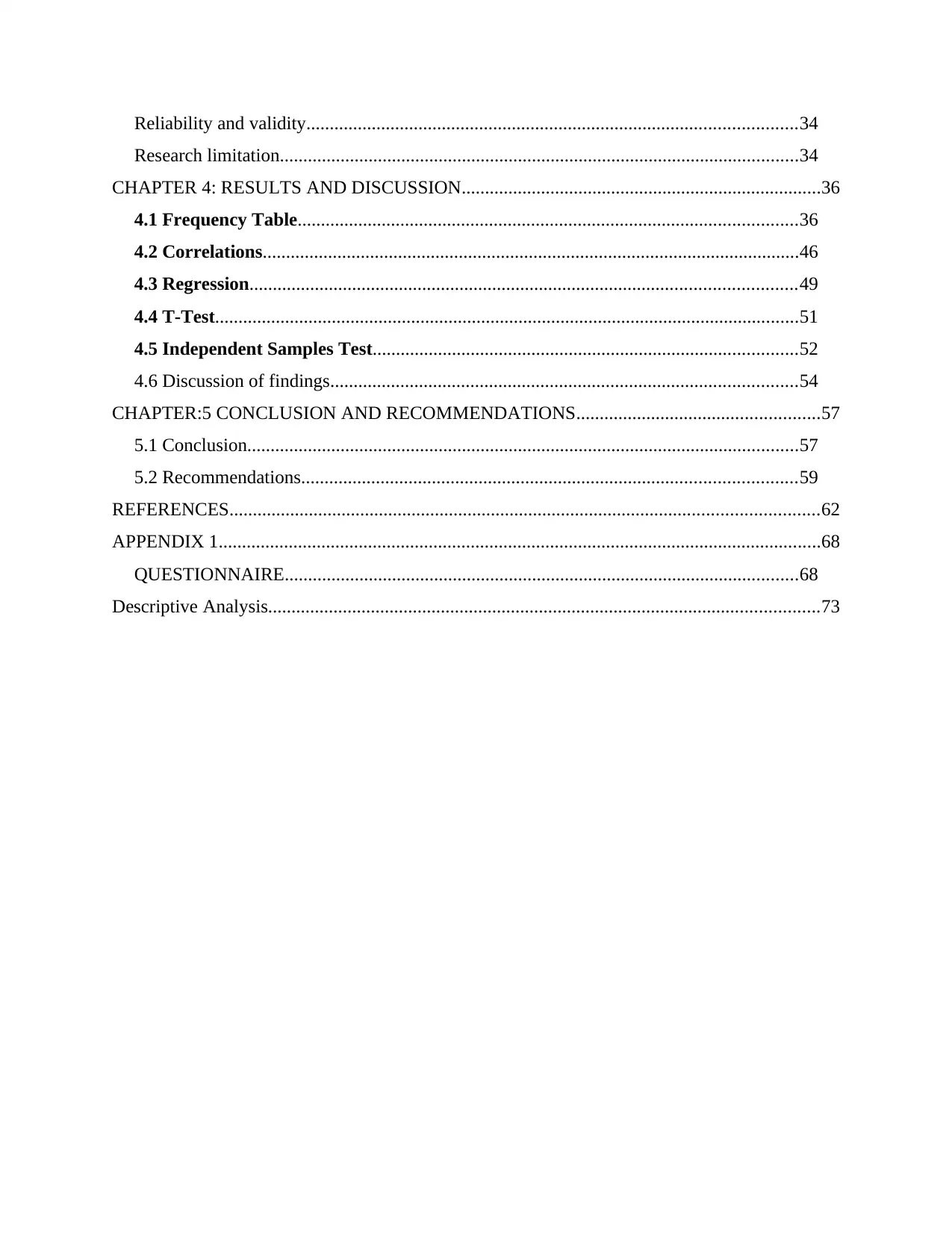
Reliability and validity.........................................................................................................34
Research limitation...............................................................................................................34
CHAPTER 4: RESULTS AND DISCUSSION.............................................................................36
4.1 Frequency Table...........................................................................................................36
4.2 Correlations...................................................................................................................46
4.3 Regression.....................................................................................................................49
4.4 T-Test.............................................................................................................................51
4.5 Independent Samples Test...........................................................................................52
4.6 Discussion of findings....................................................................................................54
CHAPTER:5 CONCLUSION AND RECOMMENDATIONS....................................................57
5.1 Conclusion......................................................................................................................57
5.2 Recommendations..........................................................................................................59
REFERENCES..............................................................................................................................62
APPENDIX 1.................................................................................................................................68
QUESTIONNAIRE..............................................................................................................68
Descriptive Analysis......................................................................................................................73
Research limitation...............................................................................................................34
CHAPTER 4: RESULTS AND DISCUSSION.............................................................................36
4.1 Frequency Table...........................................................................................................36
4.2 Correlations...................................................................................................................46
4.3 Regression.....................................................................................................................49
4.4 T-Test.............................................................................................................................51
4.5 Independent Samples Test...........................................................................................52
4.6 Discussion of findings....................................................................................................54
CHAPTER:5 CONCLUSION AND RECOMMENDATIONS....................................................57
5.1 Conclusion......................................................................................................................57
5.2 Recommendations..........................................................................................................59
REFERENCES..............................................................................................................................62
APPENDIX 1.................................................................................................................................68
QUESTIONNAIRE..............................................................................................................68
Descriptive Analysis......................................................................................................................73
⊘ This is a preview!⊘
Do you want full access?
Subscribe today to unlock all pages.

Trusted by 1+ million students worldwide
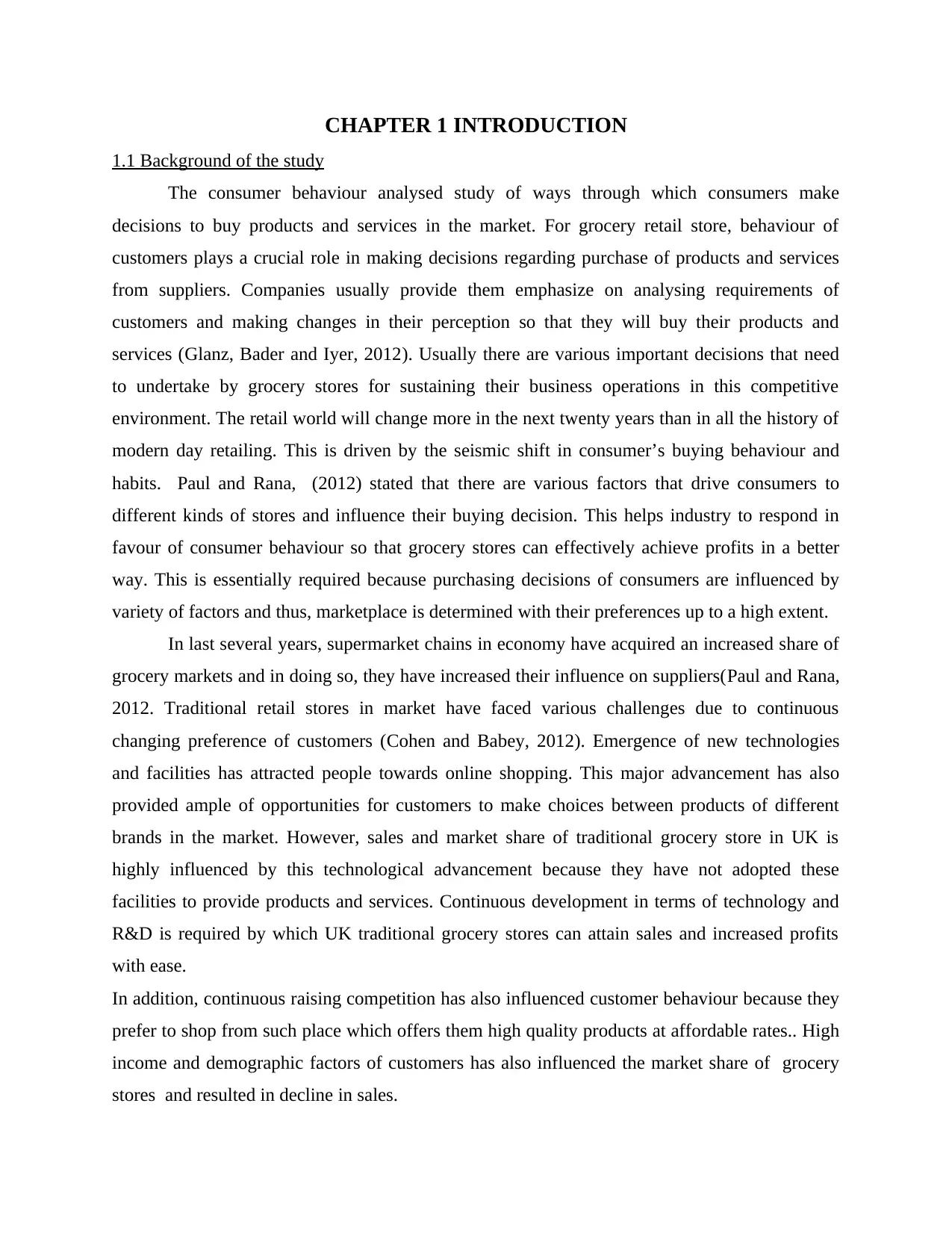
CHAPTER 1 INTRODUCTION
1.1 Background of the study
The consumer behaviour analysed study of ways through which consumers make
decisions to buy products and services in the market. For grocery retail store, behaviour of
customers plays a crucial role in making decisions regarding purchase of products and services
from suppliers. Companies usually provide them emphasize on analysing requirements of
customers and making changes in their perception so that they will buy their products and
services (Glanz, Bader and Iyer, 2012). Usually there are various important decisions that need
to undertake by grocery stores for sustaining their business operations in this competitive
environment. The retail world will change more in the next twenty years than in all the history of
modern day retailing. This is driven by the seismic shift in consumer’s buying behaviour and
habits. Paul and Rana, (2012) stated that there are various factors that drive consumers to
different kinds of stores and influence their buying decision. This helps industry to respond in
favour of consumer behaviour so that grocery stores can effectively achieve profits in a better
way. This is essentially required because purchasing decisions of consumers are influenced by
variety of factors and thus, marketplace is determined with their preferences up to a high extent.
In last several years, supermarket chains in economy have acquired an increased share of
grocery markets and in doing so, they have increased their influence on suppliers(Paul and Rana,
2012. Traditional retail stores in market have faced various challenges due to continuous
changing preference of customers (Cohen and Babey, 2012). Emergence of new technologies
and facilities has attracted people towards online shopping. This major advancement has also
provided ample of opportunities for customers to make choices between products of different
brands in the market. However, sales and market share of traditional grocery store in UK is
highly influenced by this technological advancement because they have not adopted these
facilities to provide products and services. Continuous development in terms of technology and
R&D is required by which UK traditional grocery stores can attain sales and increased profits
with ease.
In addition, continuous raising competition has also influenced customer behaviour because they
prefer to shop from such place which offers them high quality products at affordable rates.. High
income and demographic factors of customers has also influenced the market share of grocery
stores and resulted in decline in sales.
1.1 Background of the study
The consumer behaviour analysed study of ways through which consumers make
decisions to buy products and services in the market. For grocery retail store, behaviour of
customers plays a crucial role in making decisions regarding purchase of products and services
from suppliers. Companies usually provide them emphasize on analysing requirements of
customers and making changes in their perception so that they will buy their products and
services (Glanz, Bader and Iyer, 2012). Usually there are various important decisions that need
to undertake by grocery stores for sustaining their business operations in this competitive
environment. The retail world will change more in the next twenty years than in all the history of
modern day retailing. This is driven by the seismic shift in consumer’s buying behaviour and
habits. Paul and Rana, (2012) stated that there are various factors that drive consumers to
different kinds of stores and influence their buying decision. This helps industry to respond in
favour of consumer behaviour so that grocery stores can effectively achieve profits in a better
way. This is essentially required because purchasing decisions of consumers are influenced by
variety of factors and thus, marketplace is determined with their preferences up to a high extent.
In last several years, supermarket chains in economy have acquired an increased share of
grocery markets and in doing so, they have increased their influence on suppliers(Paul and Rana,
2012. Traditional retail stores in market have faced various challenges due to continuous
changing preference of customers (Cohen and Babey, 2012). Emergence of new technologies
and facilities has attracted people towards online shopping. This major advancement has also
provided ample of opportunities for customers to make choices between products of different
brands in the market. However, sales and market share of traditional grocery store in UK is
highly influenced by this technological advancement because they have not adopted these
facilities to provide products and services. Continuous development in terms of technology and
R&D is required by which UK traditional grocery stores can attain sales and increased profits
with ease.
In addition, continuous raising competition has also influenced customer behaviour because they
prefer to shop from such place which offers them high quality products at affordable rates.. High
income and demographic factors of customers has also influenced the market share of grocery
stores and resulted in decline in sales.
Paraphrase This Document
Need a fresh take? Get an instant paraphrase of this document with our AI Paraphraser
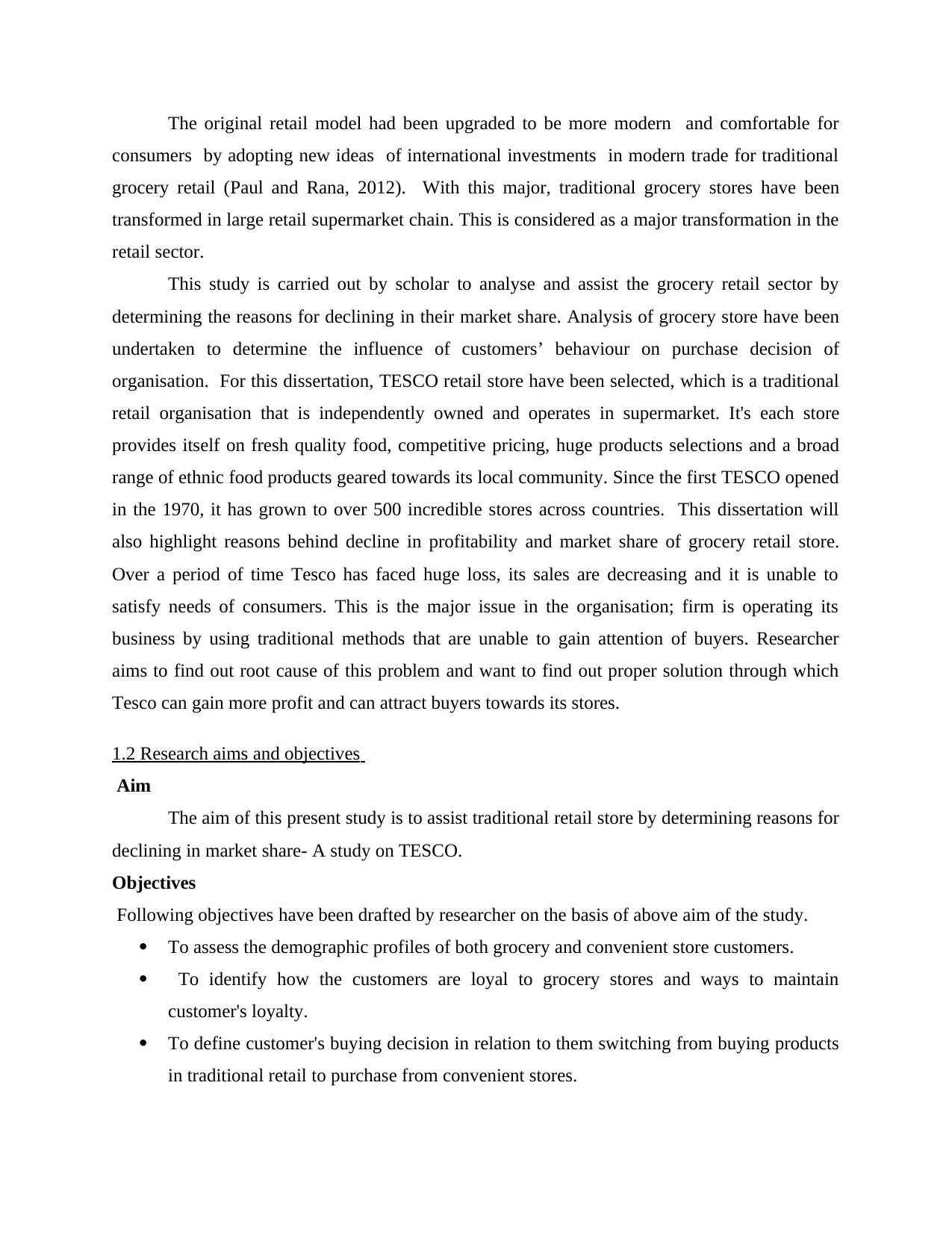
The original retail model had been upgraded to be more modern and comfortable for
consumers by adopting new ideas of international investments in modern trade for traditional
grocery retail (Paul and Rana, 2012). With this major, traditional grocery stores have been
transformed in large retail supermarket chain. This is considered as a major transformation in the
retail sector.
This study is carried out by scholar to analyse and assist the grocery retail sector by
determining the reasons for declining in their market share. Analysis of grocery store have been
undertaken to determine the influence of customers’ behaviour on purchase decision of
organisation. For this dissertation, TESCO retail store have been selected, which is a traditional
retail organisation that is independently owned and operates in supermarket. It's each store
provides itself on fresh quality food, competitive pricing, huge products selections and a broad
range of ethnic food products geared towards its local community. Since the first TESCO opened
in the 1970, it has grown to over 500 incredible stores across countries. This dissertation will
also highlight reasons behind decline in profitability and market share of grocery retail store.
Over a period of time Tesco has faced huge loss, its sales are decreasing and it is unable to
satisfy needs of consumers. This is the major issue in the organisation; firm is operating its
business by using traditional methods that are unable to gain attention of buyers. Researcher
aims to find out root cause of this problem and want to find out proper solution through which
Tesco can gain more profit and can attract buyers towards its stores.
1.2 Research aims and objectives
Aim
The aim of this present study is to assist traditional retail store by determining reasons for
declining in market share- A study on TESCO.
Objectives
Following objectives have been drafted by researcher on the basis of above aim of the study.
To assess the demographic profiles of both grocery and convenient store customers.
To identify how the customers are loyal to grocery stores and ways to maintain
customer's loyalty.
To define customer's buying decision in relation to them switching from buying products
in traditional retail to purchase from convenient stores.
consumers by adopting new ideas of international investments in modern trade for traditional
grocery retail (Paul and Rana, 2012). With this major, traditional grocery stores have been
transformed in large retail supermarket chain. This is considered as a major transformation in the
retail sector.
This study is carried out by scholar to analyse and assist the grocery retail sector by
determining the reasons for declining in their market share. Analysis of grocery store have been
undertaken to determine the influence of customers’ behaviour on purchase decision of
organisation. For this dissertation, TESCO retail store have been selected, which is a traditional
retail organisation that is independently owned and operates in supermarket. It's each store
provides itself on fresh quality food, competitive pricing, huge products selections and a broad
range of ethnic food products geared towards its local community. Since the first TESCO opened
in the 1970, it has grown to over 500 incredible stores across countries. This dissertation will
also highlight reasons behind decline in profitability and market share of grocery retail store.
Over a period of time Tesco has faced huge loss, its sales are decreasing and it is unable to
satisfy needs of consumers. This is the major issue in the organisation; firm is operating its
business by using traditional methods that are unable to gain attention of buyers. Researcher
aims to find out root cause of this problem and want to find out proper solution through which
Tesco can gain more profit and can attract buyers towards its stores.
1.2 Research aims and objectives
Aim
The aim of this present study is to assist traditional retail store by determining reasons for
declining in market share- A study on TESCO.
Objectives
Following objectives have been drafted by researcher on the basis of above aim of the study.
To assess the demographic profiles of both grocery and convenient store customers.
To identify how the customers are loyal to grocery stores and ways to maintain
customer's loyalty.
To define customer's buying decision in relation to them switching from buying products
in traditional retail to purchase from convenient stores.
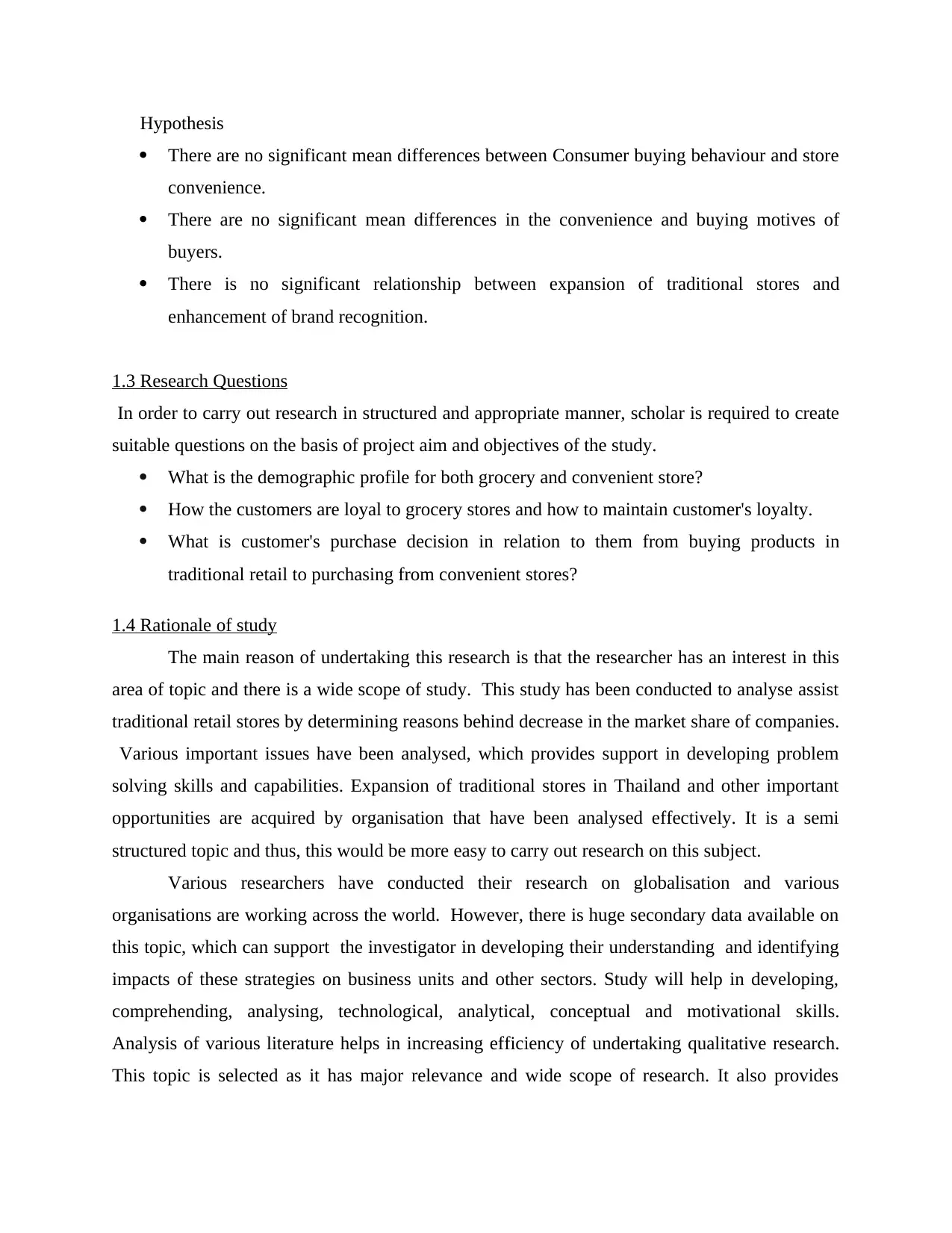
Hypothesis
There are no significant mean differences between Consumer buying behaviour and store
convenience.
There are no significant mean differences in the convenience and buying motives of
buyers.
There is no significant relationship between expansion of traditional stores and
enhancement of brand recognition.
1.3 Research Questions
In order to carry out research in structured and appropriate manner, scholar is required to create
suitable questions on the basis of project aim and objectives of the study.
What is the demographic profile for both grocery and convenient store?
How the customers are loyal to grocery stores and how to maintain customer's loyalty.
What is customer's purchase decision in relation to them from buying products in
traditional retail to purchasing from convenient stores?
1.4 Rationale of study
The main reason of undertaking this research is that the researcher has an interest in this
area of topic and there is a wide scope of study. This study has been conducted to analyse assist
traditional retail stores by determining reasons behind decrease in the market share of companies.
Various important issues have been analysed, which provides support in developing problem
solving skills and capabilities. Expansion of traditional stores in Thailand and other important
opportunities are acquired by organisation that have been analysed effectively. It is a semi
structured topic and thus, this would be more easy to carry out research on this subject.
Various researchers have conducted their research on globalisation and various
organisations are working across the world. However, there is huge secondary data available on
this topic, which can support the investigator in developing their understanding and identifying
impacts of these strategies on business units and other sectors. Study will help in developing,
comprehending, analysing, technological, analytical, conceptual and motivational skills.
Analysis of various literature helps in increasing efficiency of undertaking qualitative research.
This topic is selected as it has major relevance and wide scope of research. It also provides
There are no significant mean differences between Consumer buying behaviour and store
convenience.
There are no significant mean differences in the convenience and buying motives of
buyers.
There is no significant relationship between expansion of traditional stores and
enhancement of brand recognition.
1.3 Research Questions
In order to carry out research in structured and appropriate manner, scholar is required to create
suitable questions on the basis of project aim and objectives of the study.
What is the demographic profile for both grocery and convenient store?
How the customers are loyal to grocery stores and how to maintain customer's loyalty.
What is customer's purchase decision in relation to them from buying products in
traditional retail to purchasing from convenient stores?
1.4 Rationale of study
The main reason of undertaking this research is that the researcher has an interest in this
area of topic and there is a wide scope of study. This study has been conducted to analyse assist
traditional retail stores by determining reasons behind decrease in the market share of companies.
Various important issues have been analysed, which provides support in developing problem
solving skills and capabilities. Expansion of traditional stores in Thailand and other important
opportunities are acquired by organisation that have been analysed effectively. It is a semi
structured topic and thus, this would be more easy to carry out research on this subject.
Various researchers have conducted their research on globalisation and various
organisations are working across the world. However, there is huge secondary data available on
this topic, which can support the investigator in developing their understanding and identifying
impacts of these strategies on business units and other sectors. Study will help in developing,
comprehending, analysing, technological, analytical, conceptual and motivational skills.
Analysis of various literature helps in increasing efficiency of undertaking qualitative research.
This topic is selected as it has major relevance and wide scope of research. It also provides
⊘ This is a preview!⊘
Do you want full access?
Subscribe today to unlock all pages.

Trusted by 1+ million students worldwide
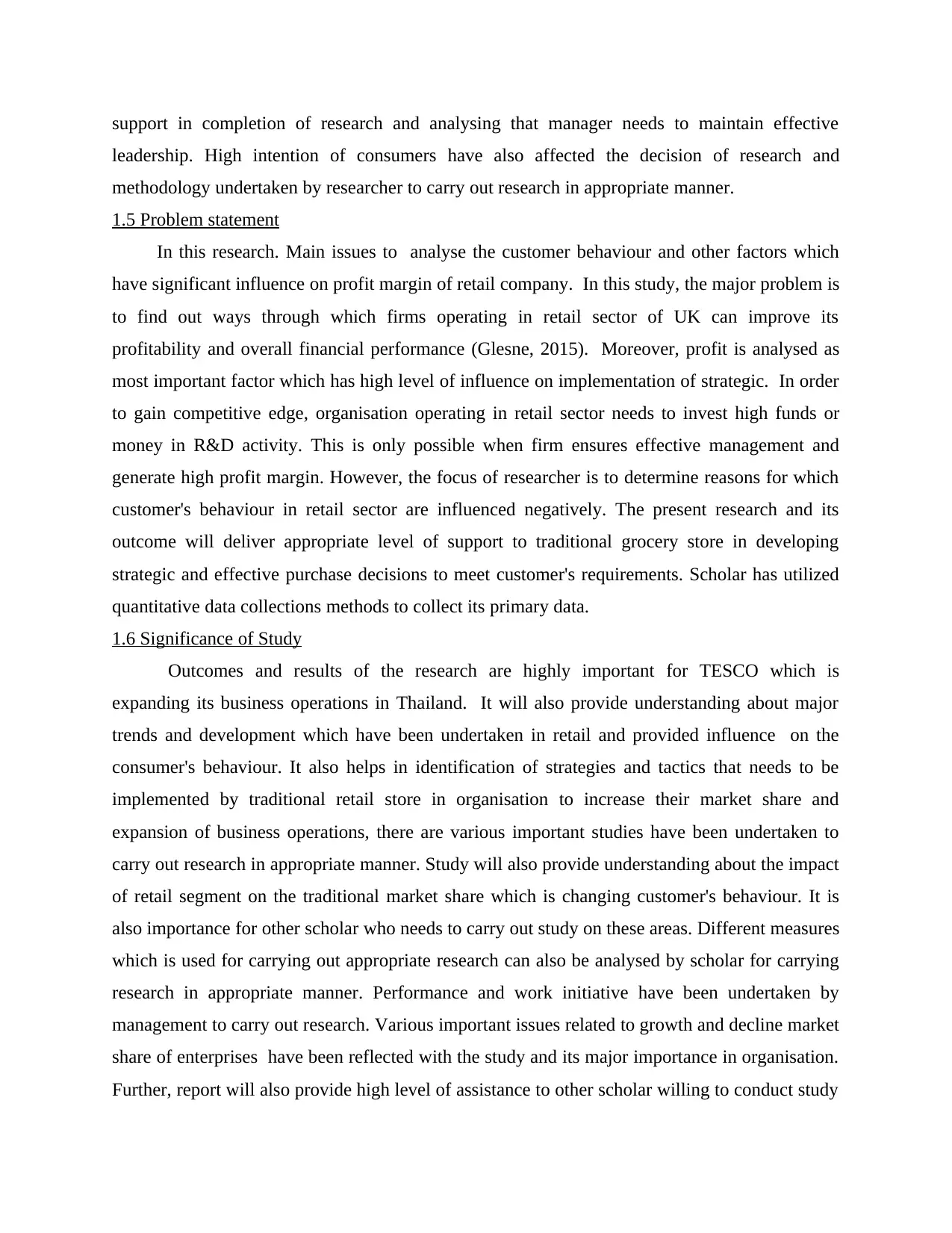
support in completion of research and analysing that manager needs to maintain effective
leadership. High intention of consumers have also affected the decision of research and
methodology undertaken by researcher to carry out research in appropriate manner.
1.5 Problem statement
In this research. Main issues to analyse the customer behaviour and other factors which
have significant influence on profit margin of retail company. In this study, the major problem is
to find out ways through which firms operating in retail sector of UK can improve its
profitability and overall financial performance (Glesne, 2015). Moreover, profit is analysed as
most important factor which has high level of influence on implementation of strategic. In order
to gain competitive edge, organisation operating in retail sector needs to invest high funds or
money in R&D activity. This is only possible when firm ensures effective management and
generate high profit margin. However, the focus of researcher is to determine reasons for which
customer's behaviour in retail sector are influenced negatively. The present research and its
outcome will deliver appropriate level of support to traditional grocery store in developing
strategic and effective purchase decisions to meet customer's requirements. Scholar has utilized
quantitative data collections methods to collect its primary data.
1.6 Significance of Study
Outcomes and results of the research are highly important for TESCO which is
expanding its business operations in Thailand. It will also provide understanding about major
trends and development which have been undertaken in retail and provided influence on the
consumer's behaviour. It also helps in identification of strategies and tactics that needs to be
implemented by traditional retail store in organisation to increase their market share and
expansion of business operations, there are various important studies have been undertaken to
carry out research in appropriate manner. Study will also provide understanding about the impact
of retail segment on the traditional market share which is changing customer's behaviour. It is
also importance for other scholar who needs to carry out study on these areas. Different measures
which is used for carrying out appropriate research can also be analysed by scholar for carrying
research in appropriate manner. Performance and work initiative have been undertaken by
management to carry out research. Various important issues related to growth and decline market
share of enterprises have been reflected with the study and its major importance in organisation.
Further, report will also provide high level of assistance to other scholar willing to conduct study
leadership. High intention of consumers have also affected the decision of research and
methodology undertaken by researcher to carry out research in appropriate manner.
1.5 Problem statement
In this research. Main issues to analyse the customer behaviour and other factors which
have significant influence on profit margin of retail company. In this study, the major problem is
to find out ways through which firms operating in retail sector of UK can improve its
profitability and overall financial performance (Glesne, 2015). Moreover, profit is analysed as
most important factor which has high level of influence on implementation of strategic. In order
to gain competitive edge, organisation operating in retail sector needs to invest high funds or
money in R&D activity. This is only possible when firm ensures effective management and
generate high profit margin. However, the focus of researcher is to determine reasons for which
customer's behaviour in retail sector are influenced negatively. The present research and its
outcome will deliver appropriate level of support to traditional grocery store in developing
strategic and effective purchase decisions to meet customer's requirements. Scholar has utilized
quantitative data collections methods to collect its primary data.
1.6 Significance of Study
Outcomes and results of the research are highly important for TESCO which is
expanding its business operations in Thailand. It will also provide understanding about major
trends and development which have been undertaken in retail and provided influence on the
consumer's behaviour. It also helps in identification of strategies and tactics that needs to be
implemented by traditional retail store in organisation to increase their market share and
expansion of business operations, there are various important studies have been undertaken to
carry out research in appropriate manner. Study will also provide understanding about the impact
of retail segment on the traditional market share which is changing customer's behaviour. It is
also importance for other scholar who needs to carry out study on these areas. Different measures
which is used for carrying out appropriate research can also be analysed by scholar for carrying
research in appropriate manner. Performance and work initiative have been undertaken by
management to carry out research. Various important issues related to growth and decline market
share of enterprises have been reflected with the study and its major importance in organisation.
Further, report will also provide high level of assistance to other scholar willing to conduct study
Paraphrase This Document
Need a fresh take? Get an instant paraphrase of this document with our AI Paraphraser
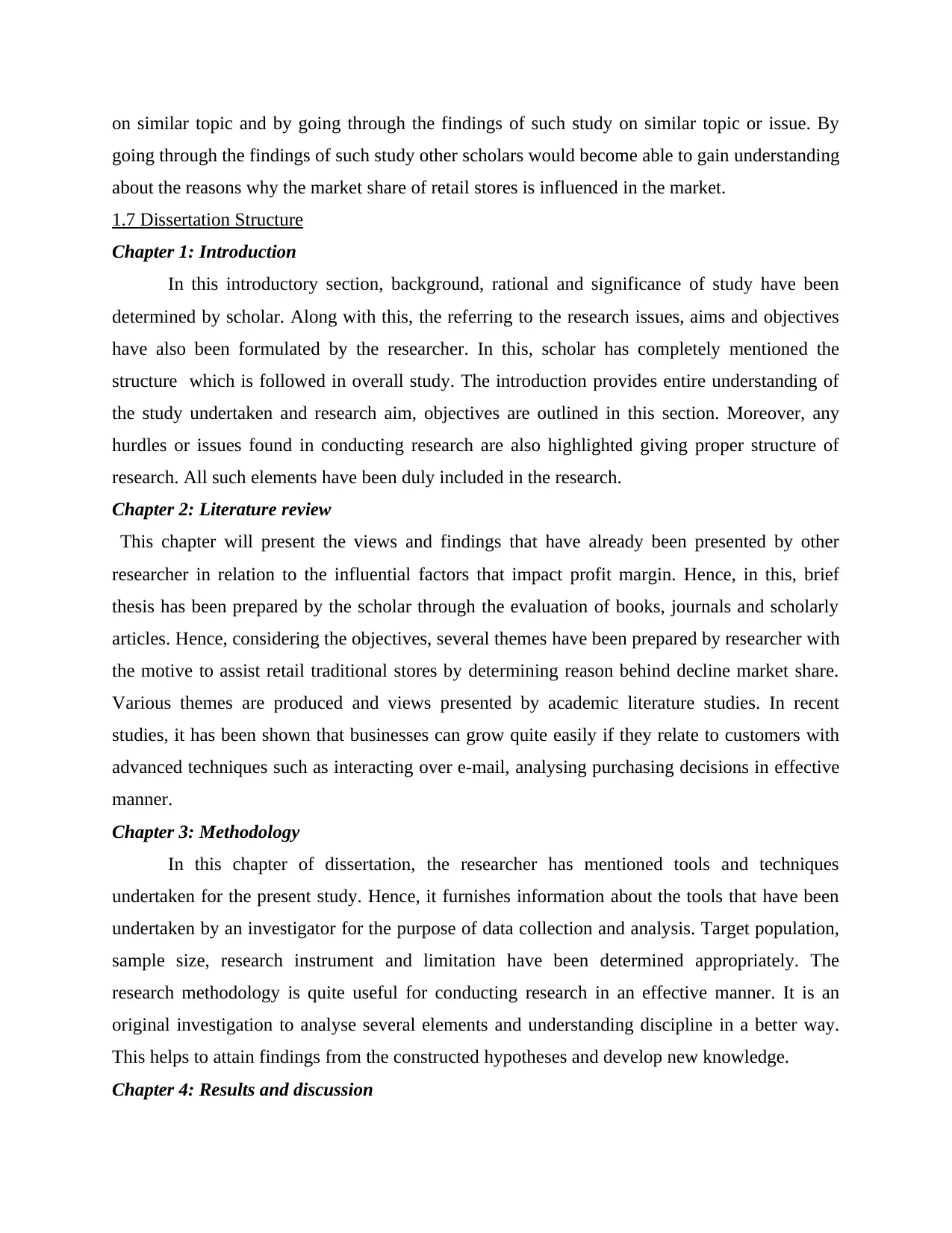
on similar topic and by going through the findings of such study on similar topic or issue. By
going through the findings of such study other scholars would become able to gain understanding
about the reasons why the market share of retail stores is influenced in the market.
1.7 Dissertation Structure
Chapter 1: Introduction
In this introductory section, background, rational and significance of study have been
determined by scholar. Along with this, the referring to the research issues, aims and objectives
have also been formulated by the researcher. In this, scholar has completely mentioned the
structure which is followed in overall study. The introduction provides entire understanding of
the study undertaken and research aim, objectives are outlined in this section. Moreover, any
hurdles or issues found in conducting research are also highlighted giving proper structure of
research. All such elements have been duly included in the research.
Chapter 2: Literature review
This chapter will present the views and findings that have already been presented by other
researcher in relation to the influential factors that impact profit margin. Hence, in this, brief
thesis has been prepared by the scholar through the evaluation of books, journals and scholarly
articles. Hence, considering the objectives, several themes have been prepared by researcher with
the motive to assist retail traditional stores by determining reason behind decline market share.
Various themes are produced and views presented by academic literature studies. In recent
studies, it has been shown that businesses can grow quite easily if they relate to customers with
advanced techniques such as interacting over e-mail, analysing purchasing decisions in effective
manner.
Chapter 3: Methodology
In this chapter of dissertation, the researcher has mentioned tools and techniques
undertaken for the present study. Hence, it furnishes information about the tools that have been
undertaken by an investigator for the purpose of data collection and analysis. Target population,
sample size, research instrument and limitation have been determined appropriately. The
research methodology is quite useful for conducting research in an effective manner. It is an
original investigation to analyse several elements and understanding discipline in a better way.
This helps to attain findings from the constructed hypotheses and develop new knowledge.
Chapter 4: Results and discussion
going through the findings of such study other scholars would become able to gain understanding
about the reasons why the market share of retail stores is influenced in the market.
1.7 Dissertation Structure
Chapter 1: Introduction
In this introductory section, background, rational and significance of study have been
determined by scholar. Along with this, the referring to the research issues, aims and objectives
have also been formulated by the researcher. In this, scholar has completely mentioned the
structure which is followed in overall study. The introduction provides entire understanding of
the study undertaken and research aim, objectives are outlined in this section. Moreover, any
hurdles or issues found in conducting research are also highlighted giving proper structure of
research. All such elements have been duly included in the research.
Chapter 2: Literature review
This chapter will present the views and findings that have already been presented by other
researcher in relation to the influential factors that impact profit margin. Hence, in this, brief
thesis has been prepared by the scholar through the evaluation of books, journals and scholarly
articles. Hence, considering the objectives, several themes have been prepared by researcher with
the motive to assist retail traditional stores by determining reason behind decline market share.
Various themes are produced and views presented by academic literature studies. In recent
studies, it has been shown that businesses can grow quite easily if they relate to customers with
advanced techniques such as interacting over e-mail, analysing purchasing decisions in effective
manner.
Chapter 3: Methodology
In this chapter of dissertation, the researcher has mentioned tools and techniques
undertaken for the present study. Hence, it furnishes information about the tools that have been
undertaken by an investigator for the purpose of data collection and analysis. Target population,
sample size, research instrument and limitation have been determined appropriately. The
research methodology is quite useful for conducting research in an effective manner. It is an
original investigation to analyse several elements and understanding discipline in a better way.
This helps to attain findings from the constructed hypotheses and develop new knowledge.
Chapter 4: Results and discussion
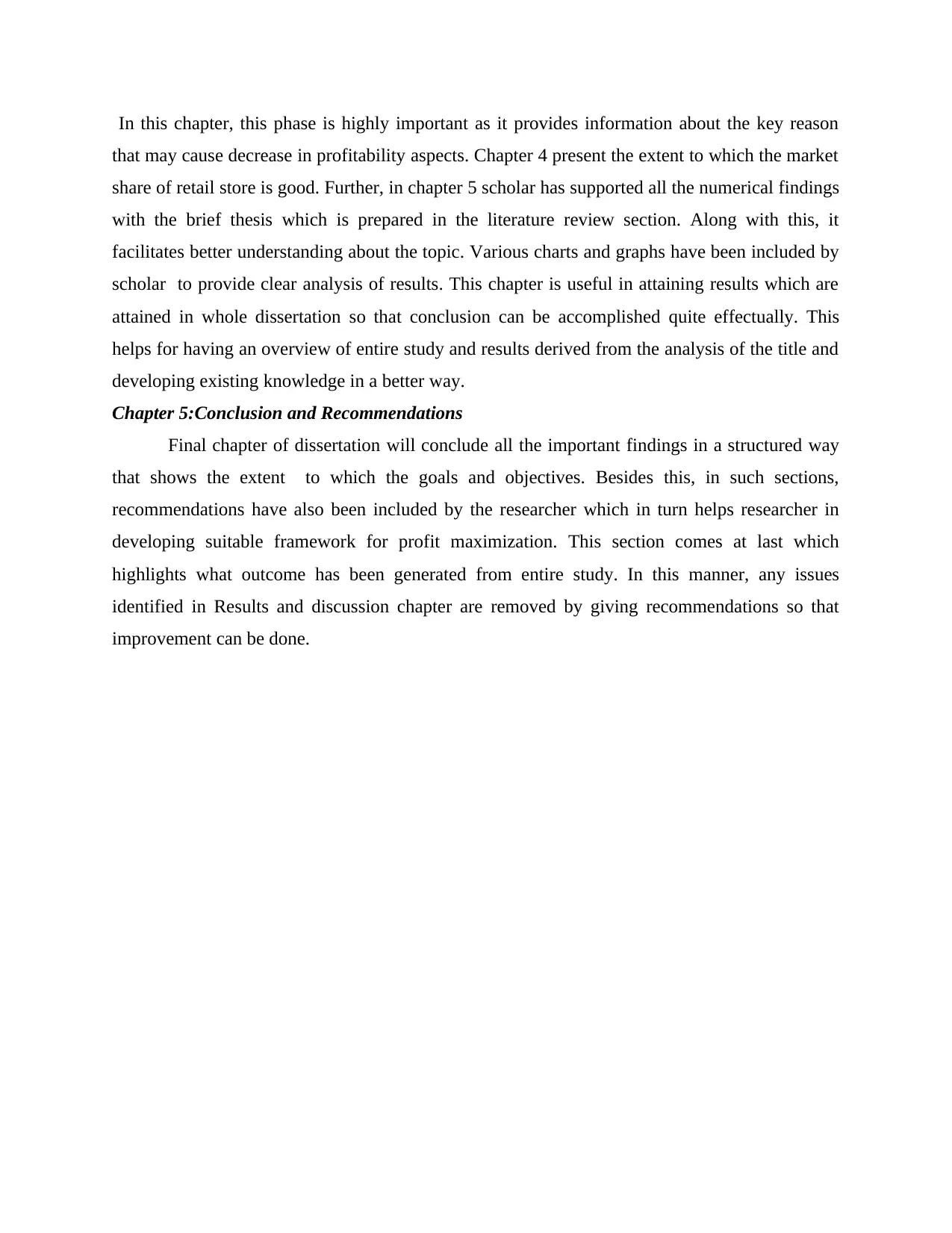
In this chapter, this phase is highly important as it provides information about the key reason
that may cause decrease in profitability aspects. Chapter 4 present the extent to which the market
share of retail store is good. Further, in chapter 5 scholar has supported all the numerical findings
with the brief thesis which is prepared in the literature review section. Along with this, it
facilitates better understanding about the topic. Various charts and graphs have been included by
scholar to provide clear analysis of results. This chapter is useful in attaining results which are
attained in whole dissertation so that conclusion can be accomplished quite effectually. This
helps for having an overview of entire study and results derived from the analysis of the title and
developing existing knowledge in a better way.
Chapter 5:Conclusion and Recommendations
Final chapter of dissertation will conclude all the important findings in a structured way
that shows the extent to which the goals and objectives. Besides this, in such sections,
recommendations have also been included by the researcher which in turn helps researcher in
developing suitable framework for profit maximization. This section comes at last which
highlights what outcome has been generated from entire study. In this manner, any issues
identified in Results and discussion chapter are removed by giving recommendations so that
improvement can be done.
that may cause decrease in profitability aspects. Chapter 4 present the extent to which the market
share of retail store is good. Further, in chapter 5 scholar has supported all the numerical findings
with the brief thesis which is prepared in the literature review section. Along with this, it
facilitates better understanding about the topic. Various charts and graphs have been included by
scholar to provide clear analysis of results. This chapter is useful in attaining results which are
attained in whole dissertation so that conclusion can be accomplished quite effectually. This
helps for having an overview of entire study and results derived from the analysis of the title and
developing existing knowledge in a better way.
Chapter 5:Conclusion and Recommendations
Final chapter of dissertation will conclude all the important findings in a structured way
that shows the extent to which the goals and objectives. Besides this, in such sections,
recommendations have also been included by the researcher which in turn helps researcher in
developing suitable framework for profit maximization. This section comes at last which
highlights what outcome has been generated from entire study. In this manner, any issues
identified in Results and discussion chapter are removed by giving recommendations so that
improvement can be done.
⊘ This is a preview!⊘
Do you want full access?
Subscribe today to unlock all pages.

Trusted by 1+ million students worldwide
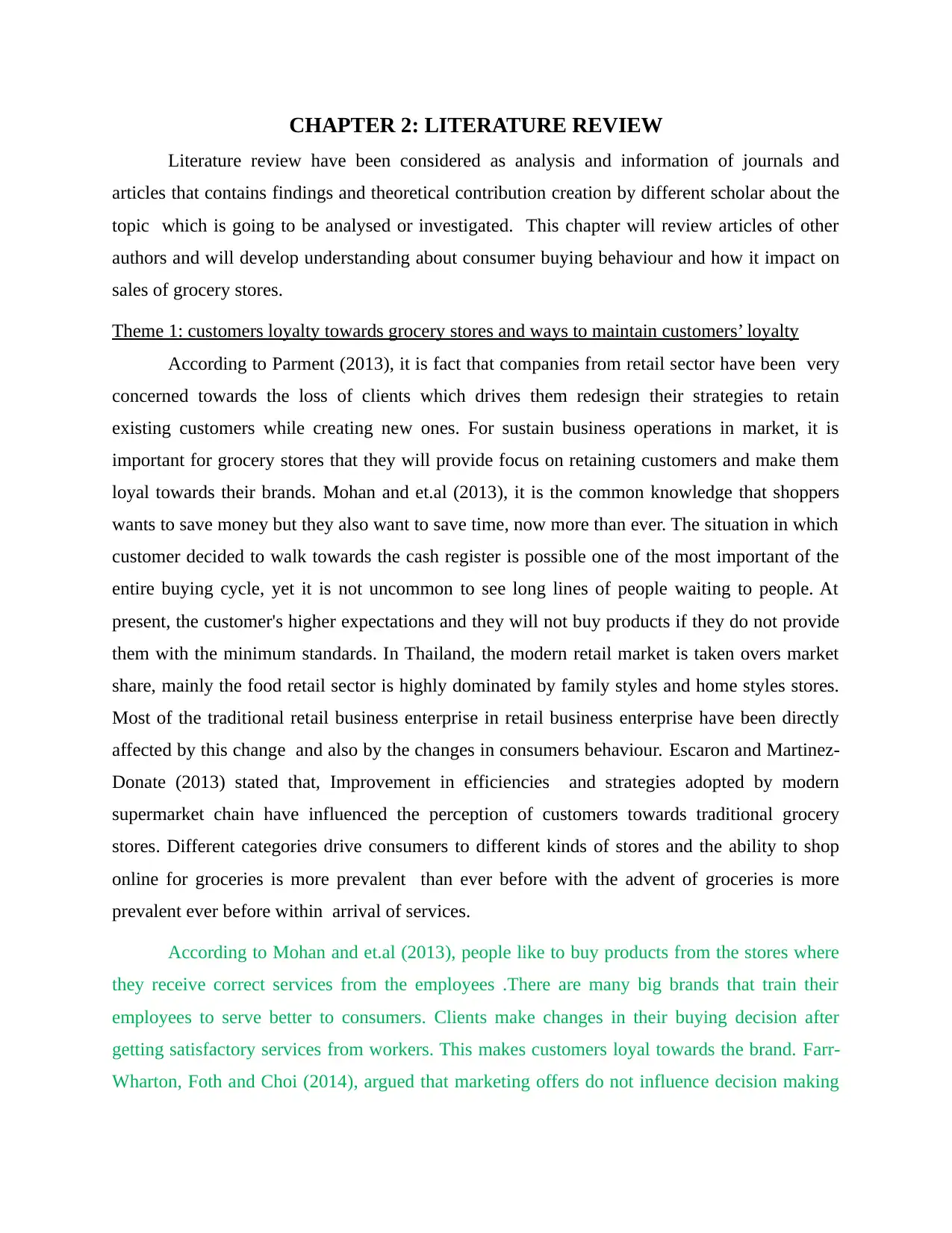
CHAPTER 2: LITERATURE REVIEW
Literature review have been considered as analysis and information of journals and
articles that contains findings and theoretical contribution creation by different scholar about the
topic which is going to be analysed or investigated. This chapter will review articles of other
authors and will develop understanding about consumer buying behaviour and how it impact on
sales of grocery stores.
Theme 1: customers loyalty towards grocery stores and ways to maintain customers’ loyalty
According to Parment (2013), it is fact that companies from retail sector have been very
concerned towards the loss of clients which drives them redesign their strategies to retain
existing customers while creating new ones. For sustain business operations in market, it is
important for grocery stores that they will provide focus on retaining customers and make them
loyal towards their brands. Mohan and et.al (2013), it is the common knowledge that shoppers
wants to save money but they also want to save time, now more than ever. The situation in which
customer decided to walk towards the cash register is possible one of the most important of the
entire buying cycle, yet it is not uncommon to see long lines of people waiting to people. At
present, the customer's higher expectations and they will not buy products if they do not provide
them with the minimum standards. In Thailand, the modern retail market is taken overs market
share, mainly the food retail sector is highly dominated by family styles and home styles stores.
Most of the traditional retail business enterprise in retail business enterprise have been directly
affected by this change and also by the changes in consumers behaviour. Escaron and Martinez-
Donate (2013) stated that, Improvement in efficiencies and strategies adopted by modern
supermarket chain have influenced the perception of customers towards traditional grocery
stores. Different categories drive consumers to different kinds of stores and the ability to shop
online for groceries is more prevalent than ever before with the advent of groceries is more
prevalent ever before within arrival of services.
According to Mohan and et.al (2013), people like to buy products from the stores where
they receive correct services from the employees .There are many big brands that train their
employees to serve better to consumers. Clients make changes in their buying decision after
getting satisfactory services from workers. This makes customers loyal towards the brand. Farr‐
Wharton, Foth and Choi (2014), argued that marketing offers do not influence decision making
Literature review have been considered as analysis and information of journals and
articles that contains findings and theoretical contribution creation by different scholar about the
topic which is going to be analysed or investigated. This chapter will review articles of other
authors and will develop understanding about consumer buying behaviour and how it impact on
sales of grocery stores.
Theme 1: customers loyalty towards grocery stores and ways to maintain customers’ loyalty
According to Parment (2013), it is fact that companies from retail sector have been very
concerned towards the loss of clients which drives them redesign their strategies to retain
existing customers while creating new ones. For sustain business operations in market, it is
important for grocery stores that they will provide focus on retaining customers and make them
loyal towards their brands. Mohan and et.al (2013), it is the common knowledge that shoppers
wants to save money but they also want to save time, now more than ever. The situation in which
customer decided to walk towards the cash register is possible one of the most important of the
entire buying cycle, yet it is not uncommon to see long lines of people waiting to people. At
present, the customer's higher expectations and they will not buy products if they do not provide
them with the minimum standards. In Thailand, the modern retail market is taken overs market
share, mainly the food retail sector is highly dominated by family styles and home styles stores.
Most of the traditional retail business enterprise in retail business enterprise have been directly
affected by this change and also by the changes in consumers behaviour. Escaron and Martinez-
Donate (2013) stated that, Improvement in efficiencies and strategies adopted by modern
supermarket chain have influenced the perception of customers towards traditional grocery
stores. Different categories drive consumers to different kinds of stores and the ability to shop
online for groceries is more prevalent than ever before with the advent of groceries is more
prevalent ever before within arrival of services.
According to Mohan and et.al (2013), people like to buy products from the stores where
they receive correct services from the employees .There are many big brands that train their
employees to serve better to consumers. Clients make changes in their buying decision after
getting satisfactory services from workers. This makes customers loyal towards the brand. Farr‐
Wharton, Foth and Choi (2014), argued that marketing offers do not influence decision making
Paraphrase This Document
Need a fresh take? Get an instant paraphrase of this document with our AI Paraphraser
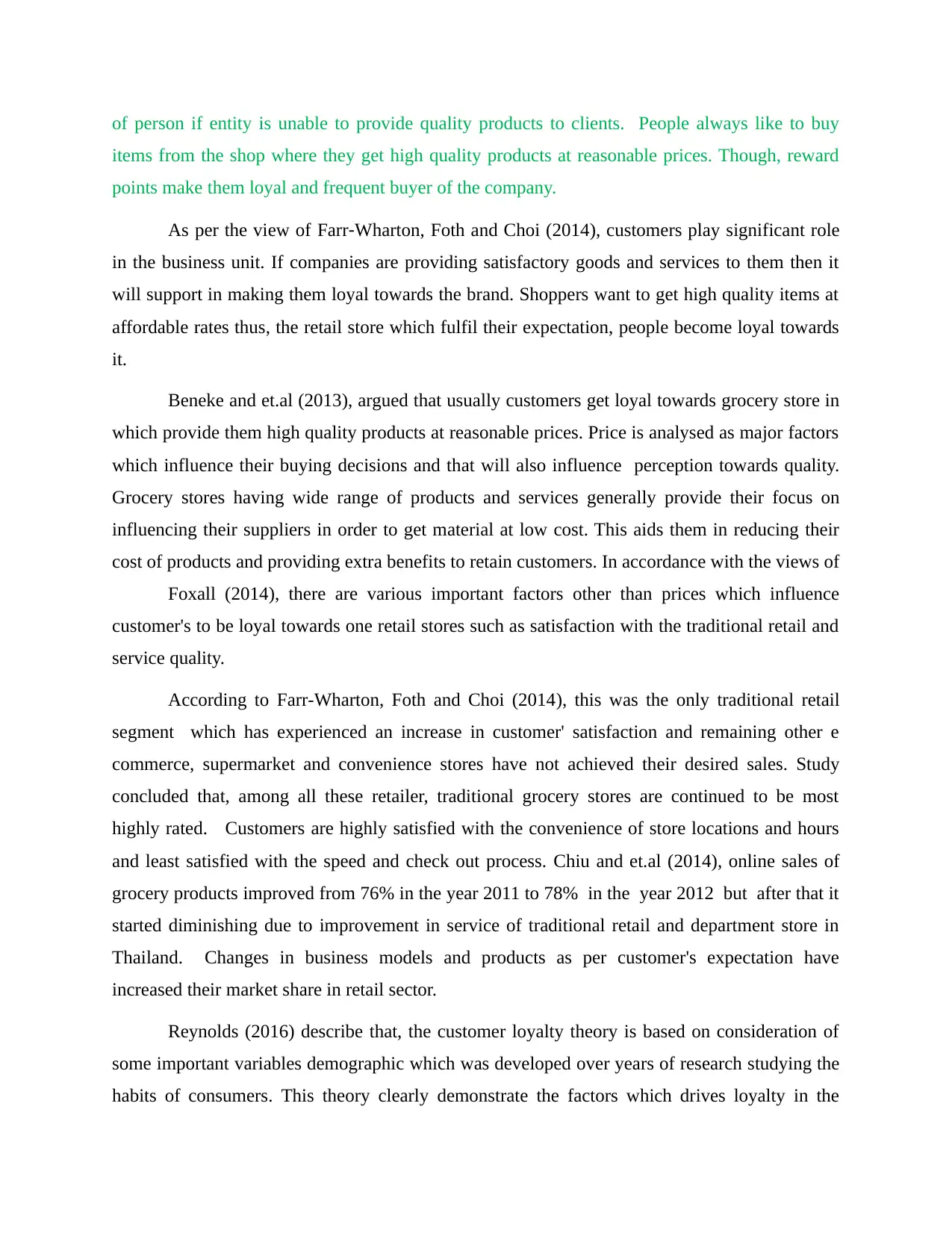
of person if entity is unable to provide quality products to clients. People always like to buy
items from the shop where they get high quality products at reasonable prices. Though, reward
points make them loyal and frequent buyer of the company.
As per the view of Farr‐Wharton, Foth and Choi (2014), customers play significant role
in the business unit. If companies are providing satisfactory goods and services to them then it
will support in making them loyal towards the brand. Shoppers want to get high quality items at
affordable rates thus, the retail store which fulfil their expectation, people become loyal towards
it.
Beneke and et.al (2013), argued that usually customers get loyal towards grocery store in
which provide them high quality products at reasonable prices. Price is analysed as major factors
which influence their buying decisions and that will also influence perception towards quality.
Grocery stores having wide range of products and services generally provide their focus on
influencing their suppliers in order to get material at low cost. This aids them in reducing their
cost of products and providing extra benefits to retain customers. In accordance with the views of
Foxall (2014), there are various important factors other than prices which influence
customer's to be loyal towards one retail stores such as satisfaction with the traditional retail and
service quality.
According to Farr‐Wharton, Foth and Choi (2014), this was the only traditional retail
segment which has experienced an increase in customer' satisfaction and remaining other e
commerce, supermarket and convenience stores have not achieved their desired sales. Study
concluded that, among all these retailer, traditional grocery stores are continued to be most
highly rated. Customers are highly satisfied with the convenience of store locations and hours
and least satisfied with the speed and check out process. Chiu and et.al (2014), online sales of
grocery products improved from 76% in the year 2011 to 78% in the year 2012 but after that it
started diminishing due to improvement in service of traditional retail and department store in
Thailand. Changes in business models and products as per customer's expectation have
increased their market share in retail sector.
Reynolds (2016) describe that, the customer loyalty theory is based on consideration of
some important variables demographic which was developed over years of research studying the
habits of consumers. This theory clearly demonstrate the factors which drives loyalty in the
items from the shop where they get high quality products at reasonable prices. Though, reward
points make them loyal and frequent buyer of the company.
As per the view of Farr‐Wharton, Foth and Choi (2014), customers play significant role
in the business unit. If companies are providing satisfactory goods and services to them then it
will support in making them loyal towards the brand. Shoppers want to get high quality items at
affordable rates thus, the retail store which fulfil their expectation, people become loyal towards
it.
Beneke and et.al (2013), argued that usually customers get loyal towards grocery store in
which provide them high quality products at reasonable prices. Price is analysed as major factors
which influence their buying decisions and that will also influence perception towards quality.
Grocery stores having wide range of products and services generally provide their focus on
influencing their suppliers in order to get material at low cost. This aids them in reducing their
cost of products and providing extra benefits to retain customers. In accordance with the views of
Foxall (2014), there are various important factors other than prices which influence
customer's to be loyal towards one retail stores such as satisfaction with the traditional retail and
service quality.
According to Farr‐Wharton, Foth and Choi (2014), this was the only traditional retail
segment which has experienced an increase in customer' satisfaction and remaining other e
commerce, supermarket and convenience stores have not achieved their desired sales. Study
concluded that, among all these retailer, traditional grocery stores are continued to be most
highly rated. Customers are highly satisfied with the convenience of store locations and hours
and least satisfied with the speed and check out process. Chiu and et.al (2014), online sales of
grocery products improved from 76% in the year 2011 to 78% in the year 2012 but after that it
started diminishing due to improvement in service of traditional retail and department store in
Thailand. Changes in business models and products as per customer's expectation have
increased their market share in retail sector.
Reynolds (2016) describe that, the customer loyalty theory is based on consideration of
some important variables demographic which was developed over years of research studying the
habits of consumers. This theory clearly demonstrate the factors which drives loyalty in the
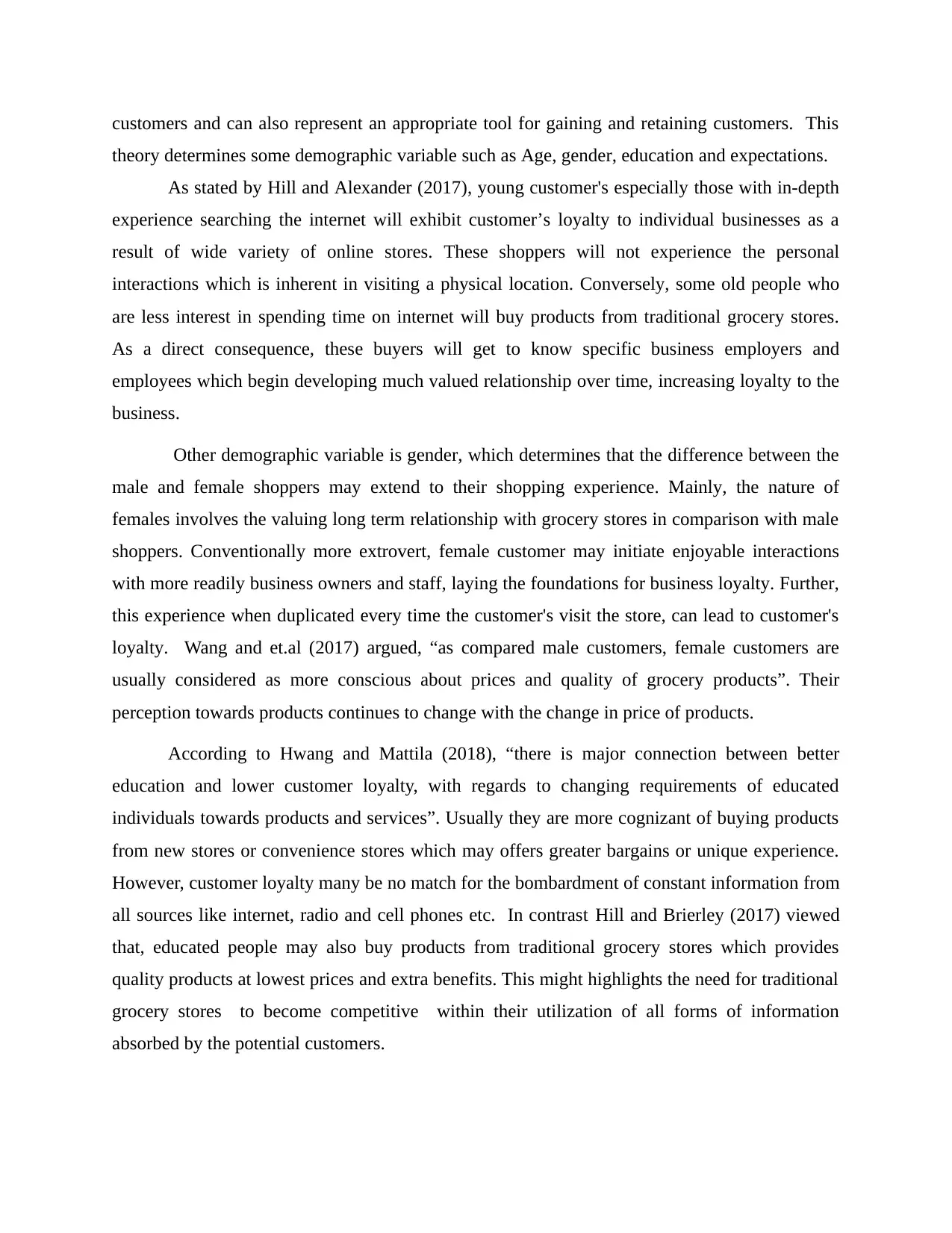
customers and can also represent an appropriate tool for gaining and retaining customers. This
theory determines some demographic variable such as Age, gender, education and expectations.
As stated by Hill and Alexander (2017), young customer's especially those with in-depth
experience searching the internet will exhibit customer’s loyalty to individual businesses as a
result of wide variety of online stores. These shoppers will not experience the personal
interactions which is inherent in visiting a physical location. Conversely, some old people who
are less interest in spending time on internet will buy products from traditional grocery stores.
As a direct consequence, these buyers will get to know specific business employers and
employees which begin developing much valued relationship over time, increasing loyalty to the
business.
Other demographic variable is gender, which determines that the difference between the
male and female shoppers may extend to their shopping experience. Mainly, the nature of
females involves the valuing long term relationship with grocery stores in comparison with male
shoppers. Conventionally more extrovert, female customer may initiate enjoyable interactions
with more readily business owners and staff, laying the foundations for business loyalty. Further,
this experience when duplicated every time the customer's visit the store, can lead to customer's
loyalty. Wang and et.al (2017) argued, “as compared male customers, female customers are
usually considered as more conscious about prices and quality of grocery products”. Their
perception towards products continues to change with the change in price of products.
According to Hwang and Mattila (2018), “there is major connection between better
education and lower customer loyalty, with regards to changing requirements of educated
individuals towards products and services”. Usually they are more cognizant of buying products
from new stores or convenience stores which may offers greater bargains or unique experience.
However, customer loyalty many be no match for the bombardment of constant information from
all sources like internet, radio and cell phones etc. In contrast Hill and Brierley (2017) viewed
that, educated people may also buy products from traditional grocery stores which provides
quality products at lowest prices and extra benefits. This might highlights the need for traditional
grocery stores to become competitive within their utilization of all forms of information
absorbed by the potential customers.
theory determines some demographic variable such as Age, gender, education and expectations.
As stated by Hill and Alexander (2017), young customer's especially those with in-depth
experience searching the internet will exhibit customer’s loyalty to individual businesses as a
result of wide variety of online stores. These shoppers will not experience the personal
interactions which is inherent in visiting a physical location. Conversely, some old people who
are less interest in spending time on internet will buy products from traditional grocery stores.
As a direct consequence, these buyers will get to know specific business employers and
employees which begin developing much valued relationship over time, increasing loyalty to the
business.
Other demographic variable is gender, which determines that the difference between the
male and female shoppers may extend to their shopping experience. Mainly, the nature of
females involves the valuing long term relationship with grocery stores in comparison with male
shoppers. Conventionally more extrovert, female customer may initiate enjoyable interactions
with more readily business owners and staff, laying the foundations for business loyalty. Further,
this experience when duplicated every time the customer's visit the store, can lead to customer's
loyalty. Wang and et.al (2017) argued, “as compared male customers, female customers are
usually considered as more conscious about prices and quality of grocery products”. Their
perception towards products continues to change with the change in price of products.
According to Hwang and Mattila (2018), “there is major connection between better
education and lower customer loyalty, with regards to changing requirements of educated
individuals towards products and services”. Usually they are more cognizant of buying products
from new stores or convenience stores which may offers greater bargains or unique experience.
However, customer loyalty many be no match for the bombardment of constant information from
all sources like internet, radio and cell phones etc. In contrast Hill and Brierley (2017) viewed
that, educated people may also buy products from traditional grocery stores which provides
quality products at lowest prices and extra benefits. This might highlights the need for traditional
grocery stores to become competitive within their utilization of all forms of information
absorbed by the potential customers.
⊘ This is a preview!⊘
Do you want full access?
Subscribe today to unlock all pages.

Trusted by 1+ million students worldwide
1 out of 77
Related Documents
Your All-in-One AI-Powered Toolkit for Academic Success.
+13062052269
info@desklib.com
Available 24*7 on WhatsApp / Email
![[object Object]](/_next/static/media/star-bottom.7253800d.svg)
Unlock your academic potential
Copyright © 2020–2025 A2Z Services. All Rights Reserved. Developed and managed by ZUCOL.





